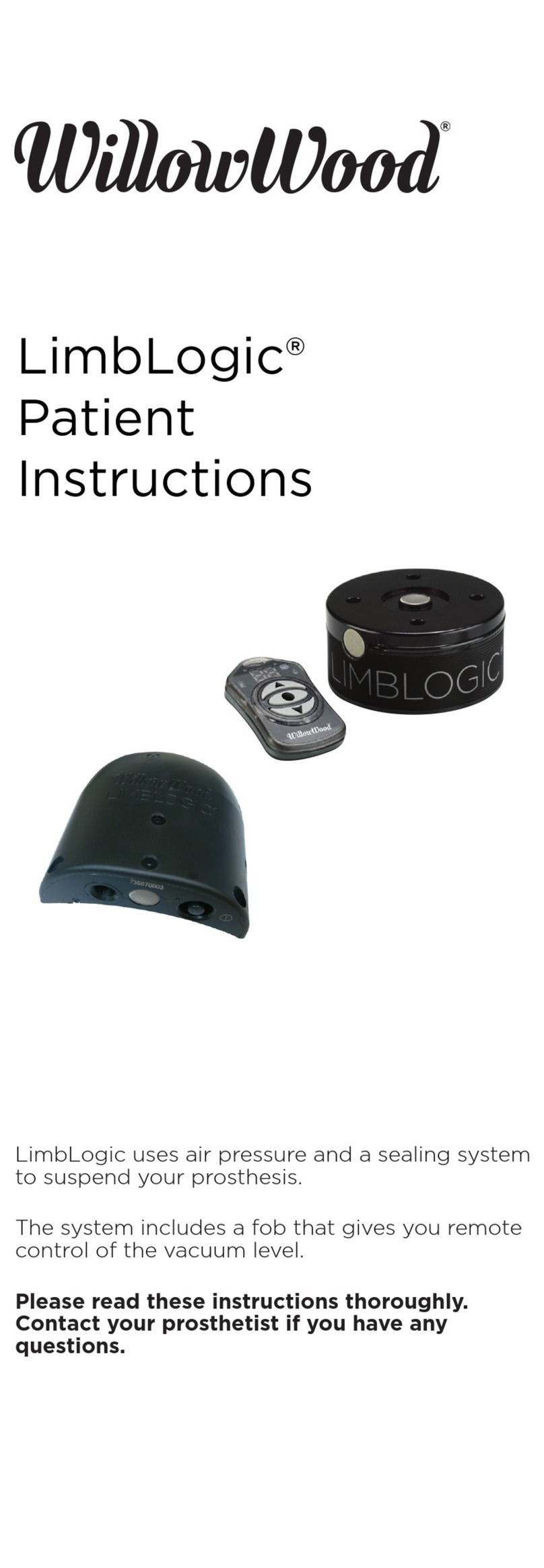
Failure to follow WillowWood instructions will void
the warranty.
Since WillowWood believes that the liners must
be fit and dispensed by a qualified professional,
please understand that WillowWood will not ship
liners directly to an amputee’s home.
PN-1191-AT 16 AUG 2016
The Drying Stand must be
assembled from the two
base components and the
tube that are included in
the box. Begin by sliding
the notch on Part A into the
notch on Part B as shown.
ASSEMBLING THE DRYING STAND*
POSSIBLE LINER ISSUES
Then place the tube
onto the assembled
base.
If you wish to have a
shorter Drying Stand
to accommodate
shorter liners, simply
trim the tube to the
desired length before
placing the tube on
the base.
Thank you for using this liner. In order to
ensure the highest level of comfort and
longest possible life from your liner,
please take the following steps:
• Read the pamphlet and follow the
directions carefully.
• Inspect your liners after each day of use.
Unusual wear may indicate changes in
the prosthetic fit. In order to preserve
the warranty, be sure to contact your
prosthetist immediately if you notice
unusual wear.
• Consult this pamphlet for suggested
solutions to common issues related to
liner use.
• Contact your prosthetist if you have any
questions about your liners.
WARNING FOR LOCKING LINER USERS:
Each of your Locking Liners should have its
own pin, securely fastened to the liner by your
prosthetist. If you do not check the locking pin
each time you put on your prosthesis to make
sure that the pin is still secure, the pin could
come out of the liner, resulting in the potential
for you to fall and injure yourself.
WillowWood also recommends the use of
an auxiliary suspension method such as a
suspension sleeve.
A
B
The Ohio Willow Wood Company
15441 Scioto Darby Road
Mt. Sterling, OH 43143
phone 740.869.3377 / 800.848.4930
fax 740.869.4374
www.willowwoodco.com
Ohio Willow Wood Company B.V
Keizersgracht 62/64
1015 CS Amsterdam
The Netherlands
Patent www.willowwoodco.com/
education-and-resources/patents
Problem Probable Cause Solution
Locking Liner is “pistoning” up
and down in your socket.
Your limb may have shrunk. Contact your prosthetist
Top edge of liner is rolling down
your leg.
Liner is possibly too short or
too tight.
Contact your prosthetist.
Heavy sweating (if you have
just recently started wearing
the liner).
Your body has not yet
adjusted to the liner.
If you are still sweating after several weeks of liner use,
contact your prosthetist. Also, some amputees have
found that it helps to apply moderate amounts of
unscented alum-based antiperspirant to the residual
limb before putting on the liner. Always follow your
prosthetist’s instructions and the directions on the
product label. Note: non-alum-based products may
damage the liner.
Heavy sweating (if you had
been wearing the liner for a
long time without sweating,
and suddenly started sweating
again).
Air is getting between the
liner and the residual limb,
possibly because your limb
has shrunk.
Contact your prosthetist.
There is a hole in the liner. Contact your prosthetist.
Heavy sweating (if you are
wearing a SmartTemp Liner)
The SmartTemp Liner has
become saturated with body
heat.
Discharge the body heat in a cool environment.
Skin irritation all over your
residual limb.
Not cleaning or disinfecting
your liner correctly.
Make sure that you are following the proper cleaning,
rinsing, and disinfection procedures outlined in this
pamphlet.
Use of a harsh or irritation
lotion, cream, powder, or
soap.
Have you recently started using a dierent cleaning
product? (For some amputees, anti-bacterial soap has
caused skin irritations.) Have you recently started using
any products that contain hydrocarbon oils or animal
fats/oils? If so, discontinue using the product.
Washing the limb too
frequently.
Washing the limb more than once per day can result in
increased levels of skin irritation.
Fungal and/or bacterial
infection of the limb and liner.
Contact your prosthetist. You may also need to contact
a dermatologist.
The liner or the socket is loose,
possibly because your limb
has shrunk.
Contact your prosthetist.
Skin irritation along the top
edge of your liner.
The liner is being pulled onto
the limb instead of being rolled
onto the limb, or the liner is
too tight.
Refer to the instructions in this pamphlet for putting
on your liner. If the problem continues, contact your
prosthetist.
Open wounds and non-intact
skin.
Contact your prosthetist
immediately.
Always follow your prosthetist’s directions, and never
use a liner in direct contact with open sores or
non-intact skin. If the liner must be worn over open
sores or non-intact skin, wear a bandage or other
appropriate covering over the wound to prevent direct
contact between the wound and the liner.
Patient Instructions
• AlphaBasic™ Liners
• Alpha ClassicLiners
• Alpha Duo™ Liners
• Alpha HybridLiners
• Alpha SiliconeLiners
• Alpha SmartTempLiners
• WillowWoodExpress Liners
*not included with the Alpha Basic Liner.























